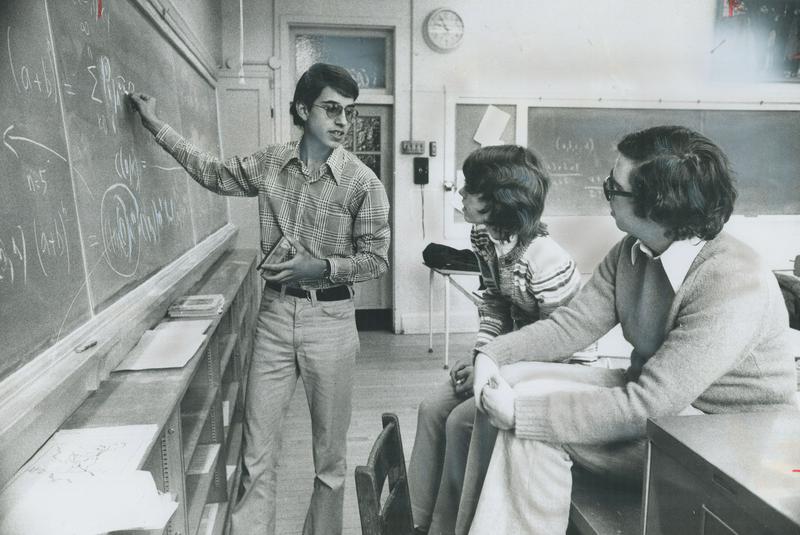New Math: The Curriculum That Failed Students And Teachers
By | October 25, 2018

They're two words that still scare teachers and schoolchildren of the 1960s: New Math. This dreaded and traumatic change in the teaching of basic mathematics had young kids pondering abstract algebra, modular arithmetic, matrices, symbolic logic, Boolean algebra, and other super-mathy stuff they might never need. New Math confused everybody, and didn't seem to pay off -- kids were wrangling with abstract ideas about math without actually being able to get the right answer.
When the Soviet Union launched Sputnik into orbit in the closing years of the 1950s, it served as a wake-up call for Americans. In that one moment, Americans, who had prided themselves on being the best nation in the world, were forced to admit they'd been bested by the Russians. The solution, many experts claimed, was education reform, particularly in mathematics. In the 1960s and 1970s, as a result, schools adopted a radical new math curriculum that confounded teachers, parents and students and became a national disaster. Here’s how.
Experts Blamed Traditional Math Textbooks

Math had always been taught using drills and repeated practices until the skills were mastered. Skills built upon each other. But education experts and mathematicians who advocated for the New Math curriculum wanted to include higher order math along with the basics, as a way to show students how math connects to real-world problem-solving. The overall goal was to produce high school graduates with advanced mathematics skills who would be ready to tackle new technology.
New Math Introduced Theoretical Math Along With Practical Math

Much of the concept of New Math was retraining the brain to think of math in abstract ways. The theoretical components were blended in with the concrete math and a new, intimidating vocabulary was introduced that included terms like “Boolean algebra” and “Matrices”. Students who were still learning their multiplication tables were being taught to find the value of “x”. They had to understand the difference between numbers and numerals, as well as symbolic logic. Students were learning about things like “truth sets” and “commutative law,” but not learning simple arithmetic.
There Are Bases Other Than 10?

In traditional math, ten is the base. Number milestones are based on the number ten…10, 100, 1000, and so on. New Math showed students that there are other bases besides the base ten system…a mind-blowing concept to most school children and their parents. Students learned to add and multiply by viewing numbers in their place order and were taught, for example, to look at the number 47 not as 47, but as 4 tens and 7 ones.
New Math Confused Teachers And Drove Parents Crazy

As the nation’s schools were eager to hop aboard the New Math train and make quick and radical curriculum changes, teachers were expected to be able to effectively teach New Math using the hundreds of new textbooks that were being published each year. The problem was, many of the teachers didn’t understand it either. For an experienced teacher who had been effectively teaching traditional math for years, the sudden switch to New Math presented a daunting challenge for them. Many teachers had to return to the classroom themselves in order to understand what they were teaching. Other teachers muddled through without having a firm grasp of the material.
New Math represented such a radical shift from traditional math education that the majority of parents didn’t understand it. When their children came to them for help with their math homework, the nation’s parents collectively threw up their hands and scratched their heads. Concerned parents demanded that the teachers and the schools explain the New Math curriculum to them. Some schools allowed parents to sit in on their child’s math class. Others provided evening classes for parents to help them learn the material so they could help their children. But most parents simply gave up and refused to help their children with math.
New Math Grew… But Was It Working?

As more and more mathematicians, educators and politicians promoted New Math as the means to regain the country’s technological superiority, and more and more New Math textbooks were being thrown at students, there was one thing they were forgetting to ask…is it working? Education experts were reluctant to look at the assessment numbers too soon. They knew that the outcomes would be lower during the transition period after implementing New Math. So certain were they that the New Math curriculum was the salvation of American education, that they were willing to continue the curriculum despite the massive amount of concern and criticism from teachers and parents.
New Math Was A Failure

Dismal report after dismal report pointed to the fact that New Math was not working. By the mid- to late-1970s, education experts were forced to concede that New Math was a failure. The methodology of New Math that seemed logical was actually creating more confusion in students. That confusion led to apathy. Students were not excelling at math, were not prepared for college-level mathematics, and were not interested in pursuing careers in math. Morris Kline stated in his groundbreaking book Why Johnny Can’t Add: The Failure of New Math that the curriculum “ignored completely the fact that mathematics is a cumulative development and that it is practically impossible to learn newer creations if one does not know the older ones.”
Good Riddance To New Math

As the 1970s came to a close, schools were dropping the New Math curriculum and returning to more traditional ways of teaching math. In the wake of the New Math experiment was a generation of students who graduated with a poor understanding of math. And worse, a fear and hatred of the subject. This was the opposite of the original goal of New Math.
